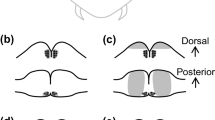Summary
Recovery of the circadian rhythm of locomotor activity after bilateral section of the optic tracts (OT) of the cockroachLeucophaea maderae was investigated. After OT section rhythmicity consistently reappeared in 3–5 weeks (29±6.2 days,n=22) (Fig. 1), while removal of the optic lobes caused permanent (> 100 days) arrythmicity (n= 13) (Fig. 2A). Recovery of rhythmicity after OT section was likely due to regeneration since:(1) Histological examination showed structural regeneration had occurred (Fig. 3A). (2) Insertion of a glass barrier between the OL and midbrain prevented (> 75 days,n=6) or slowed (46±14.9 days,n=3) rhythm recovery (Fig. 2B). (3) Extracellular recording after optic tract section showed recovery of light evoked activity in the cervical connectives (Fig. 4) whose time course paralleled the recovery of behavioral rhythmicity (Fig. 5).
The freerunning period (τ) of the rhythm after regeneration was strongly correlated with τ before surgery (r=0.87) but was slightly longer (Δτ=0.2±0.35 h) (Fig. 6). Also the phase of the rhythm, projected back to the day of surgery, was correlated with preoperative phase (r=0.61) (Fig. 7). Exposure to light cycles the first 10 days after OT section shifted the phase of the subsequent rhythm (Fig. 8). These results suggest that an entrainable circadian oscillation persists in the optic lobes after OT section.
Similar content being viewed by others
Abbreviations
- CST :
-
central standard time
- OT :
-
optic tracts
References
Brady J (1967) Control of the circadian rhythm of activity in the cockroach. II. The role of the suboesophageal ganglion and ventral nerve cord. J Exp Biol 47:165–178
Brady J (1974) The physiology of insect circadian rhythms. Adv Insect Physiol 10:1–115
Caldarola PC (1974) The interaction of temperature and heavy water on circadian pacemakers. PhD thesis, Stanford University
Cymborowski B (1981) Transplantation of circadian pacemaker in the house cricket,Acheta domesticus L. J Interdiscip Cycle Res 12:133–140
Cymborowski B, Brady J (1972) Insect circadian rhythms transmitted by parabiosis — A re-examination. Nature 236:221–222
Driskill RJ (1974) The circadian locomotor rhythm of the cockroach: An examination of the photoreceptive system operative in entrainment. Master's thesis, University of Delaware
Handler AM, Konopka RJ (1979) Transplantation of a circadian pacemaker in Drosophila. Nature 279:236–238
Lukat R (1978) Circadian growth layers in the cuticle of behaviorally arrhythmic cockroaches (Blaberus fuscus, Ins., Blattoidea). Experientia 34:477
Lukat R, Weber F (1979) The structure of locomotor activity in bilobectomized cockroaches (Blaberus fuscus). Experientia 35:38–39
Nishiitsutsuji-Uwo J, Pittendrigh CS (1968a) Central nervous system control of circadian rhythmicity in the cockroach. II. The pathway of light signals that entrain the rhythms. Z Vergl Physiol 58:1–13
Nishiitsutsuji-Uwo J, Pittendrigh CS (1968b) Central nervous system control of circadian rhythmicity in the cockroach. III. The optic lobes, locus of the driving oscillation? Z Vergl Physiol 58:14–46
Page TL (1978) Interactions between bilaterally paired components of the cockroach circadian system. J Comp Physiol 124:225–236
Page TL (1981a) Effects of localized low-temperature pulses on the cockroach circadian pacemaker. Am J Physiol 240:R144-R150
Page TL (1981b) Localization of circadian pacemakers in insects. In:Follett BK, Follett DE (eds) Biological clocks in seasonal reproductive cycles. Wright, Bristol, pp 113–124
Page TL (1981c) Neural and endocrine control of circadian rhythmicity in invertebrates. In:Aschoff J (ed) Handbook of behavioral neurobiology, vol 4. Plenum Press, New York, pp 145–172
Page TL (1982) Transplantation of the cockroach circadian pacemaker. Science 216:73–75
Page TL (1983) Clocks and circadian rhythms. In:Kerkut GA, Gilbert LI (eds) Comprehensive insect biochemistry, physiology, and pharmacology. Pergamon Press, Oxford (in press)
Page TL, Block GD (1980) Circadian rhythmicity in cockroaches: Effects of early post-embryonic development and ageing. Physiol Entomol 5:271–281
Page TL, Caldarola PC, Pittendrigh CS (1977) Mutual entrainment of bilaterally distributed circadian pacemakers. Proc Natl Acad Sci USA 74:1277–1281
Roberts SK (1965) Photoreception and entrainment of cockroach activity rhythms. Science 148:958–959
Roberts SK (1974) Circadian rhythms in cockroaches: Effects of optic lobe lesions. J Comp Physiol 88:21–30
Roberts SK, Skopik SD, Driskill RJ (1971) Circadian rhythms in cockroaches: Does brain hormone mediate the locomotor cycle? In:Menaker M (ed) Biochronometry. National Academy of Sciences, Washington, DC, pp 505–515
Sokolove PG (1975) Localization of the cockroach optic lobe circadian pacemaker with microlesions. Brain Res 87:13–21
Author information
Authors and Affiliations
Rights and permissions
About this article
Cite this article
Page, T.L. Regeneration of the optic tracts and circadian pacemaker activity in the cockroachLeucophaea maderae . J. Comp. Physiol. 152, 231–240 (1983). https://doi.org/10.1007/BF00611187
Accepted:
Issue Date:
DOI: https://doi.org/10.1007/BF00611187




